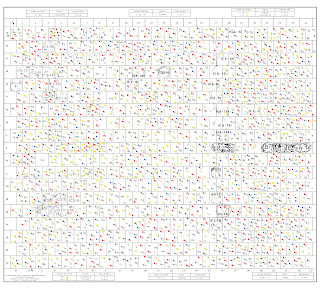The Star Maps of Star Probe, Star Empires and Star Frontiers:
The Star Maps of Star Probe, Star Empires and Star Frontiers:
Star Probe and Star Empires both use the basic same map with the main difference being Star Probe’s is in color and latter Star Empires is in black and white. Both maps are a staggered square hex system with each square representing 5 light years. The maps are actually 3 dimensional and the systems marked to represent light years above and below the 0 plane. The result is a map measuring 150 light years by 100 light years by 115 light years. These maps contain over 2,000 star systems. Each star system is further classified by using yellow circles for regular stars (yellow, orange, white, etc.), blue triangles for hot stars (blue, violet, etc) and red squares for cool stars (red). Of course the black and white Star Empires Star Map just uses the shapes.
The home star system, race type and empire boundaries for each player are stamped on these maps.
Understanding the map is very important to figuring out distances between stars. If you look closely you will see underlined numbers next to the star symbol, or non-underlined numbers, or simply 0. Non-underlined numbers are above the plane 0, while underlined are below plane 0. Now these numbers represent 5 light years of space, thus a 15 really means 75 light years above the 0 plane and 15 means 75 light years below the 0 plane.
Understanding the map is very important to figuring out distances between stars. If you look closely you will see underlined numbers next to the star symbol, or non-underlined numbers, or simply 0. Non-underlined numbers are above the plane 0, while underlined are below plane 0. Now these numbers represent 5 light years of space, thus a 15 really means 75 light years above the 0 plane and 15 means 75 light years below the 0 plane.
Star Frontiers original Alpha Dawn Star Map is in 1 light year square hexes not staggered. Another difference is it is two dimensional and no star systems show their relative position to plane 0. Additionally neutron and binary stars are listed along with colonies identified along with species.
In addition Star Frontiers has two additional Star Maps, one that came with the Knight Hawks Expansion and then another that appeared in Zebulon's Guide to the Frontier. I will address these additional Star Maps latter as one is very abstract and the other expands the known space of the Frontier but is based on the above original map.
Hyper-Space (AKA Void) Jump Navigation:
In all three games ships are limited as to how far they can jump at a time. In Star Frontiers 15 light years is the safe maximum distance. However in Star Probe and Star Empires ships are assigned a number that determines how many 5 light year hexes they can jump and ship technology can be improved to jump farther distances. Thus a ship with a 4 as it's Hyper-Space Jump Distance can jump 4 x 5 for a total of 20 light years.
Star Probe introduced a way to determine light year distance between star systems. You plot the number of hexes you want to move while not counting the hex you start in, but do count the one you end in then look at the number of levels between the system and level 0. So you should now have 2 numbers. Example let's say the system you want to go is 3 hexes away and 5 down, this would be 3 and 5. Now we have to do some math per the rules "The greater numerical distance plus one half the smaller distance." So 5 + 1 1/2 = 6 1/2 so 32.5 light years. Star Empires uses this same formula.
In both Star Probe and Star Empires it takes 1 month to calculate a single jump. The exception to this rule is in Star Empires once a player has a nexus or space port established they can jump immediately from these as long as they arrive at one as well.
Star Frontiers gives no such formulas, instead it states in the expanded Alpha rules that the light years equal the travel time thus an 8 light year jump is 8 days and includes all deceleration, acceleration and plotting time. However in Knight Hawks the skill used to plot the course takes 10 hours multiplied by the light years to be transversed. Thus an 8 light year jump takes 80 hours to plot, but the astrogator must also eat and sleep during each day as well, effectively allowing the referee to keep the time required still 8 days or even more. There is however an Interstellar Distance Chart to help you figure distance between stars.
Fuel Consumption For Jumps:
In Star Probe every jump uses one Hyper-Space Fuel Slug. Star Empires works more on a fleet scale but for individual ships I would use the Star Probe rules. Star Frontiers allows for several engine types Chemical, Ion and Atomic. Only The Ion and Atomic are capable of FTL. The Atomic engines use one fuel pellet pre jump. Fuel consumption for an Ion ship requires 1,113 fuel units of hydrogen per engine per jump.
Some Conclusion:
I think the Star Probe star map and the Star Frontier star maps can be combined and two scales created easily enough or used as is by any of the three games. A TSL chart for available propulsion types and fuel consumption can be created for the more tactical Star Empires. Star Frontiers could benefit from TSL and research ideas in Star Empires. Star Probe and Star Empires could benefit from ideas in Star Frontiers concerning plotting time maybe in connection with TSL improvements in specific areas.
Playing Goals:
Currently I am running a small Star Probe game that will be then transitioned to Star Empires and finally to Star Frontiers with the goal of integrating the games better. I like the idea of epic space battles that Star Empires can produce and the ideas for smaller heroic actions that Star Frontiers is based on. The goal is to create expanded updated integrated rules that do not conflict but compliment each other.
Hyper-Space (AKA Void) Jump Navigation:
In all three games ships are limited as to how far they can jump at a time. In Star Frontiers 15 light years is the safe maximum distance. However in Star Probe and Star Empires ships are assigned a number that determines how many 5 light year hexes they can jump and ship technology can be improved to jump farther distances. Thus a ship with a 4 as it's Hyper-Space Jump Distance can jump 4 x 5 for a total of 20 light years.
Star Probe introduced a way to determine light year distance between star systems. You plot the number of hexes you want to move while not counting the hex you start in, but do count the one you end in then look at the number of levels between the system and level 0. So you should now have 2 numbers. Example let's say the system you want to go is 3 hexes away and 5 down, this would be 3 and 5. Now we have to do some math per the rules "The greater numerical distance plus one half the smaller distance." So 5 + 1 1/2 = 6 1/2 so 32.5 light years. Star Empires uses this same formula.
In both Star Probe and Star Empires it takes 1 month to calculate a single jump. The exception to this rule is in Star Empires once a player has a nexus or space port established they can jump immediately from these as long as they arrive at one as well.
Star Frontiers gives no such formulas, instead it states in the expanded Alpha rules that the light years equal the travel time thus an 8 light year jump is 8 days and includes all deceleration, acceleration and plotting time. However in Knight Hawks the skill used to plot the course takes 10 hours multiplied by the light years to be transversed. Thus an 8 light year jump takes 80 hours to plot, but the astrogator must also eat and sleep during each day as well, effectively allowing the referee to keep the time required still 8 days or even more. There is however an Interstellar Distance Chart to help you figure distance between stars.
Fuel Consumption For Jumps:
In Star Probe every jump uses one Hyper-Space Fuel Slug. Star Empires works more on a fleet scale but for individual ships I would use the Star Probe rules. Star Frontiers allows for several engine types Chemical, Ion and Atomic. Only The Ion and Atomic are capable of FTL. The Atomic engines use one fuel pellet pre jump. Fuel consumption for an Ion ship requires 1,113 fuel units of hydrogen per engine per jump.
Some Conclusion:
I think the Star Probe star map and the Star Frontier star maps can be combined and two scales created easily enough or used as is by any of the three games. A TSL chart for available propulsion types and fuel consumption can be created for the more tactical Star Empires. Star Frontiers could benefit from TSL and research ideas in Star Empires. Star Probe and Star Empires could benefit from ideas in Star Frontiers concerning plotting time maybe in connection with TSL improvements in specific areas.
Playing Goals:
Currently I am running a small Star Probe game that will be then transitioned to Star Empires and finally to Star Frontiers with the goal of integrating the games better. I like the idea of epic space battles that Star Empires can produce and the ideas for smaller heroic actions that Star Frontiers is based on. The goal is to create expanded updated integrated rules that do not conflict but compliment each other.




This is a terrific site! I am also running a Star Probe game. I'm just getting started. Looking forward to seeing more.
ReplyDeleteFor the record, I am planning to do the same with Star Empires. However, my choice for the third system is a game called Colonial Troopers.
DeleteExcellent! Glad to know I am not the only person tripping around the Star Probe Universe all old school. I look forward to seeing your conversions to Colonial Troopers.
Delete